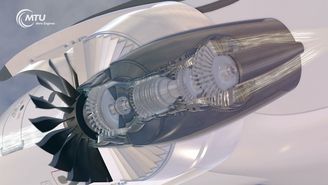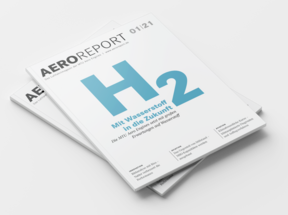
IR News details
MTU Aero Engines: Business results for 2009 fully in line with forecasts
• Revenues: € 2,610.8 million
• EBIT adjusted: € 292.3 million
• Outlook for 2010: Stable development of revenues and earnings
- Provisional figures – subject to approval by the Supervisory Board -
Munich, February 24, 2010 – MTU Aero Engines Holding AG has fully met its business forecasts for the financial year 2009. This was announced at the company’s annual press conference on February 24, 2010. MTU reported revenues of € 2,610.8 million (2008: € 2,724.3 million), in line with the targeted level of around € 2.6 billion. MTU generated an operating profit (EBIT adjusted) of € 292.3 million (2008: € 331.0 million), which is slightly higher than the upwardly revised forecast of approximately € 290 million. Net income amounted to € 141.0 million, compared with a targeted € 140 million for 2009 and a reported result of € 179.7 million in 2008. MTU significantly exceeded its free cash flow forecast: at year-end, free cash flow stood at € 120.2 million (2008: € 123.6 million), or 20% higher than the guidance of € 100 million.
“The past year presented MTU with a host of major challenges. The global economic and financial crisis, coupled with the persistently strong euro and reviving oil prices, has left its mark on our industry,” summed up Egon Behle, CEO of MTU Aero Engines Holding AG. “This being so, I am all the more delighted that MTU achieved a solid performance in 2009, meeting all quantitative targets. We have laid the foundations for a stable development in the coming year.”
Outlook for 2010
The aviation market is expected to stabilize in 2010. Passenger and freight traffic will gradually start to revive, as will the business jet sector. This recovery will be driven principally by the Asia-Pacific region and the Middle East. MTU is well positioned in this market environment, thanks to its business model and local presence in the major growth markets. In 2010, the company expects to generate revenues on the level of last year. Operating profit (EBIT adjusted) and net income are also expected to develop along stable lines. MTU’s ongoing investments in the future again involve high research and development expenditure in connection with new engine programs. Despite this, MTU anticipates a free cash flow in the order of € 100 million for 2010.
2009 revenues in line with expectations
Revenues in 2009 were impacted by the slower market demand, with the airlines reporting a marked downturn in the volume of passenger and freight traffic. Revenues in the commercial engine business amounted to € 1,053.7 million, compared with € 1,146.3 million in 2008. The highest revenues from sales of new engines and spare parts were attributable to the V2500 engine that powers the Airbus A320 family, the PW2000 used to equip the Boeing C-17, and the CF6-80C for the Boeing 747 and Airbus types A310 and A330.
MTU saw an improvement in the military engine business, where revenues increased by 7% to € 532.0 million (2008: € 496.6 million), based largely on the Eurofighter EJ200 engine and the Tornado’s RB199.
The commercial maintenance business produced revenues of € 1,057.6 million in 2009; the figure for 2008 was € 1,113.0 million. The highest contribution came from the V2500 for the Airbus A320 family.
High volume of contracts
MTU’s order backlog at December 31, 2009 amounted to € 4,150.9 million, an increase of 3% over the previous year (Dec. 31, 2008: € 4,015.7 million). This is equivalent to 1.6 times annual revenues. “Despite the difficult market environment in 2009, we have slightly increased our order backlog. This augurs well for the future, placing us in a good position for stable development in 2010,” comments Behle.
In the commercial maintenance business, the contract value for work on engines under long-term service agreements amounted to U.S. $ 6,759.6 million (2008: U.S. $ 7,278.3 million).
Profitability remains high
In 2009, MTU once again demonstrated its earnings power by producing a two-digit return on sales: the EBIT margin came to 11.2% (2008: 12.1%), thus meeting the target of 11% that MTU had set in October. The individual business segments also achieved their respective targets: the margin of 14.5% reported by the OEM business even exceeded the expected result of between 13 and 14%. Operating profit in the OEM business amounted to € 229.2 million (2008: € 279.9 million). The commercial maintenance business (MRO) improved its operating profit by 20% to € 65.3 million. This business segment’s EBIT margin of 6.2% lay within the defined target corridor of between 6 and 7%.
MTU’s net income amounted to € 141.0 million, compared with € 179.7 million in 2008.
Valuation effects arising from engine programs
MTU’s financial statements for 2009 include effects arising from the prescribed annual valuation of engine programs (impairment test). Their combined impact on operating profit (EBIT adjusted) is neutral. The revaluation of commercial engine programs resulted in a positive effect of around € 90 million. This was offset by negative effects arising from changes in identified and anticipated risks and increased costs associated with the TP400-D6 engine program for the A400M military aircraft, leading to the recognition of impairment losses also in the volume of around € 90 million. “All in all, despite the general difficulties imposed by the economic situation in 2009, MTU has been able to establish comprehensive contingencies for the TP400-D6 program,” emphasizes CFO Reiner Winkler.
Proposed dividend of € 0.93 per share
“MTU has successfully confronted the challenges of the financial year 2009. We want to share the resulting benefits with our shareholders, and thank them for their trust by proposing a dividend payment of € 0.93 per share. This is unchanged from the record-breaking year 2008,” Winkler points out.
15% of OEM revenues reinvested in research and development
Research and development expenditure increased by 27% to € 230.2 in 2009 (2008: € 181.6 million). This corresponds to roughly 15% of revenues from the OEM business, which is where the majority of these expenses are incurred. Company-funded R&D was intensified, increasing by 22% to € 123.0 million. The main focus of research and development work in 2009 lay on technologies for next-generation engines, alongside the development programs for the PW1000G for the Mitsubishi Regional Jet, Bombardier CSeries and Irkut MS-21, the GEnx for the Boeing 787 Dreamliner and Boeing 747-8, and the GE38 for the Sikorsky CH-53K heavy-lift helicopter. “In 2009, we not only systematically maintained but substantially boosted our level of investment in research and development. In this way, we not only aim to strengthen our role as a global technology leader but also to sustainably shape the future of aviation,” declares Behle.
Capital expenditure
MTU’s capital expenditure in 2009 amounted to € 140.3 million. This is lower than in 2008, mainly because the level of capital expenditure in that year was unusually high, at € 293.7 million, due to the acquisition of additional stakes in engine programs and the construction and equipment of MTU Aero Engines Polska.
7,665 employees
At the end of 2009, MTU had 7,665 employees, 2% more than at the end of 2008 (7,537 employees). The increase is due mainly to the recruitment of staff for MTU Aero Engines Polska and the expansion of the capacity of MTU Maintenance Zhuhai.
MTU Aero Engines will publish its Annual Report on March 12, 2010.
MTU Aero Engines – Key financial data for 2009
(Figures quoted in € million, calculated on a comparable basis, statements prepared in accordance with IFRS. Figures calculated on a comparative basis apply adjustments to the IFRS consolidated results to exclude restructuring and transaction costs, capitalized development costs, and the effects of IFRS purchase accounting.)
| MTU Aero Engines | 2009 | 2008 | Change |
|---|---|---|---|
| Revenues | 2,610.8 | 2,724.3 | - 4.2 % |
| of which OEM business | 1,585.7 | 1,642.9 | - 3.5 % |
| of which commercial engine business | 1,053.7 | 1,146.3 | - 8.1 % |
| of which military engine business | 532.0 | 496.6 | + 7.1 % |
| of which commercial MRO business | 1,057.6 | 1,113.0 | - 5.0 % |
| EBIT (calculated on a comparable basis) | 292.3 | 331.0 | - 11.7 % |
| of which OEM business | 229.2 | 279.9 | - 18.1 % |
| of which commercial MRO business | 65.3 | 54.6 | + 19.6 % |
| EBIT margin (calculated on a comparable basis) | 11.2 % | 12.1 % | |
| in the OEM business | 14.5 % | 17.0 % | |
| in the commercial MRO business | 6.2 % | 4.9 % | |
| Net income (IFRS) | 141.0 | 179.7 | - 21.5 % |
| Earnings per share (undiluted) | € 2.89 | € 3.64 | - 20.6 % |
| Free cash flow | 120.2 | 123.6 | - 2.8 % |
| Research and development expenses | 230.2 | 181.6 | + 26.8 % |
| of which company-funded R&D | 123.0 | 101.1 | + 21.7 % |
| of which outside-funded R&D | 107.2 | 80.5 | + 33.2 % |
| Capital expenditure | 140.3 | 293.7 | - 52.2 % |
| Dec. 31, 09 | Dec. 31, 08 | Change | |
| Order backlog | 4,150.9 | 4,015.7 | + 3.4 % |
| of which OEM business | 3,965.1 | 3,884.5 | + 2.1 % |
| of which commercial MRO business | 185.8 | 131.4 | + 41.4 % |
| Employees | 7,665 | 7,537 | + 1.7 % |
Outlook for 2010
| in € million | 2009 | Outlook 2010 |
|---|---|---|
| Revenues | 2,610.8 | stable |
| EBIT adjusted | 292.3 | stable |
| Free cash flow | 120.2 | ~ 100 |
| Net income | 141.0 | stable |
About MTU Aero Engines
MTU Aero Engines is the leading German manufacturer of aircraft engines and a major player in the industry. Together with its affiliates, MTU maintains a presence in all essential markets and regions. In the commercial engine sector, the company has close working ties with the world’s major aero engine manufacturers – General Electric, Pratt & Whitney and Rolls-Royce. In the military sector, MTU is the lead industrial partner for almost every type of engine operated by the German armed forces, and an important partner in all major military aero engine programs in Europe. MTU Maintenance is the world’s largest independent provider of MRO services for commercial aero engines. MTU is a technological leader in high-pressure compressors, low-pressure turbines, manufacturing processes, and repair techniques.
Press archive and photos: http://www.mtu.de
The Annual Report can be downloaded from the Internet at www.mtu.de under Investor Relations -> Financial Reports & Figures -> Financial Reports (from March 12, 2010 onward). It is available in PDF format or alternatively, from mid-April, in hardcopy print format.
Cautionary note regarding forward-looking statements
Certain of the statements contained herein may be statements of future expectations and other forward-looking statements that are based on management’s current views and assumptions and involve known and unknown risks and uncertainties that could cause actual results, performance or events to differ materially from those expressed or implied in such statements. Actual results, performance or events may differ materially from those in such statements due to, without limitation, competition from other companies in MTU Aero Engines’ industry and MTU Aero Engines’ ability to retain or increase its market share, the cyclicality of the airline industry, risks related to MTU Aero Engines’ participation in consortia and risk and revenue sharing agreements for new aero engine programs, risks associated with the capital markets, currency exchange rate fluctuations, regulations affecting MTU Aero Engines’ business and MTU Aero Engines’ ability to respond to changes in the regulatory environment, and other factors. Many of these factors may be more likely to occur, or more pronounced, as a result of terrorist activities and their consequences. MTU Aero Engines assumes no obligation to update any forward-looking statement.





